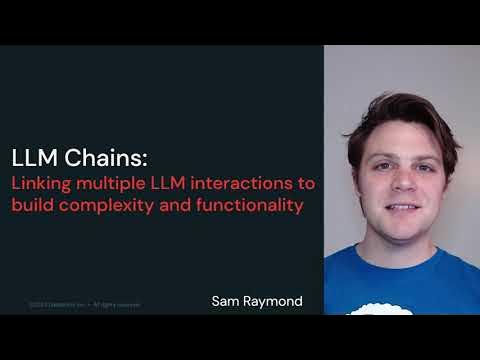LLM Module 3 - Multi-stage Reasoning | 3.3 Prompt Engineering
Summary
TLDRThis video covers best practices for prompt engineering when using large language models (LLMs) for tasks like summarization and sentiment analysis. The process starts with creating a well-structured prompt template for summarizing articles, ensuring attention to emotive language. The script demonstrates how to build the template, define variables, and create an instance of the prompt for use with a summarization LLM. The second part of the video introduces the concept of chaining LLMs, where the output of the summary model serves as input for a sentiment analysis model. The video provides a systematic approach for improving prompt effectiveness and LLM workflows.
Takeaways
- 😀 A well-written prompt can elicit a high-quality response from a large language model (LLM).
- 😀 Poorly written prompts may leave the potential performance of the LLM untapped, reducing effectiveness.
- 😀 Prompt engineering involves using best practices and a systematic approach to maximize LLM output quality.
- 😀 A prompt template for summarizing articles should be constructed step-by-step to ensure clarity and consistency.
- 😀 The summary prompt should include a clear task description, such as summarizing an article with an emphasis on emotive phrases.
- 😀 The template should include placeholders for input variables, such as the article text, which will be provided later.
- 😀 A generative model (instead of a classification model) is ideal for creating summaries of the article.
- 😀 Prompt templates can be modularized and shared across teams, improving efficiency in processing multiple articles.
- 😀 Once the article is summarized, it can be fed into a second model for sentiment analysis, creating a chain of LLMs.
- 😀 The concept of LLM chains enables the combination of different models (e.g., summarization and sentiment analysis) to solve more complex tasks.
Q & A
What is the importance of prompt engineering in working with large language models?
-Prompt engineering is essential because a well-written prompt can elicit better responses from a large language model, whereas a poorly written prompt can limit the performance and potential of the model.
How can a well-written prompt be beneficial beyond the individual task?
-A well-written prompt can save time, reduce hassle, and can be shared and modularized across teams and communities, enhancing consistency and efficiency.
What is the specific use case for the summarization prompt in the script?
-The summarization prompt is used to summarize articles, paying close attention to emotive phrases, as part of a larger workflow that includes sentiment analysis.
Why is it important to pay attention to emotive phrases when summarizing an article?
-Focusing on emotive phrases helps capture not just factual information but also the sentiment expressed in the article, which can be valuable for understanding tone and underlying emotions.
What does the syntax with curly braces represent in the prompt template?
-The curly braces define a variable that will later be filled with the specific article text to be summarized, ensuring flexibility and reusability of the prompt template.
What is the role of the summary prompt in the overall process?
-The summary prompt provides a structured input for the language model to generate a summary of the article, while ensuring it attends to emotive phrases for further sentiment analysis.
What is the purpose of the LangChain syntax mentioned in the script?
-LangChain is used here to define a prompt template and instantiate it with specific input variables, allowing the user to manage prompt creation systematically for use with large language models.
How does the chaining of large language models help in the workflow described?
-Chaining large language models allows for a two-stage process where the first model summarizes the article and the second model performs sentiment analysis on that summary, creating a seamless workflow.
What happens after the article is summarized in this process?
-After summarization, the output is passed to a sentiment analysis large language model to extract and analyze the emotional tone or sentiment of the summary.
What does the script suggest as the next step after chaining the two models?
-The script suggests exploring 'LLM chains' in more detail, which involves linking multiple large language models together to handle more complex tasks like sentiment analysis after summarization.
Outlines

This section is available to paid users only. Please upgrade to access this part.
Upgrade NowMindmap

This section is available to paid users only. Please upgrade to access this part.
Upgrade NowKeywords

This section is available to paid users only. Please upgrade to access this part.
Upgrade NowHighlights

This section is available to paid users only. Please upgrade to access this part.
Upgrade NowTranscripts

This section is available to paid users only. Please upgrade to access this part.
Upgrade NowBrowse More Related Video

What is Large Language Model (LLM)? | Artificial Intelligence Interview Questions & Answers

第1集-引言-ChatGPT提示工程师|AI大神吴恩达教你写提示词

LLM Module 3 - Multi-stage Reasoning | 3.2 Module Overview

Prompt Engineering Tutorial – Master ChatGPT and LLM Responses

Prompt Engineering

LLM Module 3 - Multi-stage Reasoning | 3.4 LLM Chains
5.0 / 5 (0 votes)